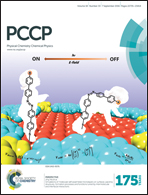Investigation on the neutral and anionic BxAlyH2 (x + y = 7, 8, 9) clusters using density functional theory combined with photoelectron spectroscopy†
Abstract
The structure and bonding nature of neutral and negatively charged BxAlyH2 (x + y = 7, 8, 9) clusters are investigated with the aid of previously published experimental photoelectron spectra combined with the present density functional theory calculations. The comparison between the experimental photoelectron spectra and theoretical simulated spectra helps to identify the ground state structures. The accuracy of the obtained ground state structures is further verified by calculating their adiabatic electron affinities and vertical detachment energies and comparing them against available experimental data. The results show that the structures of BxAlyH2 transform from three-dimensional to planar structures as the number of boron atoms increases. Moreover, boron atoms tend to bind together forming Bn units. The hydrogen atoms prefer to bind with boron atoms rather than aluminum atoms. The analyses of the molecular orbital on the ground state structures further support the abovementioned results.


 Please wait while we load your content...
Please wait while we load your content...